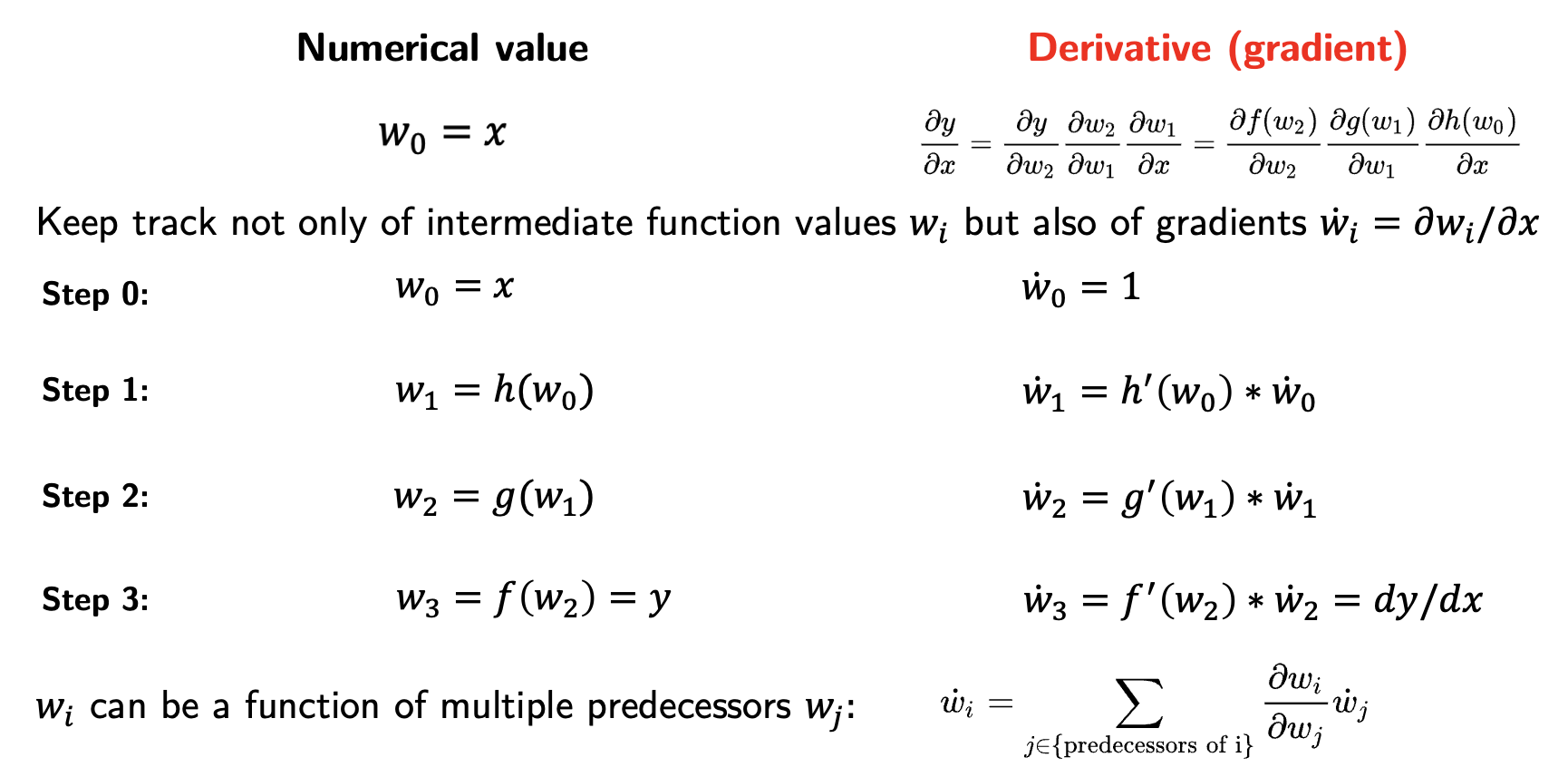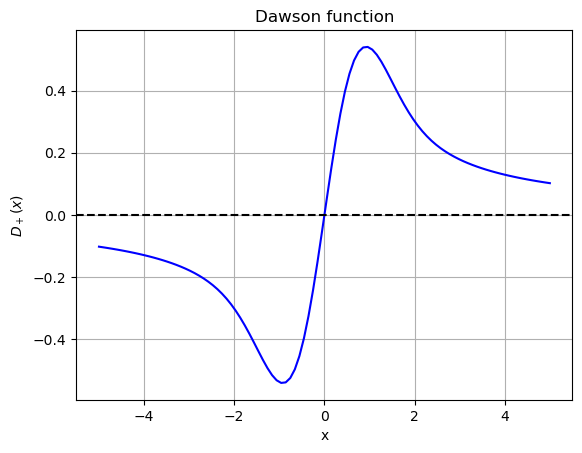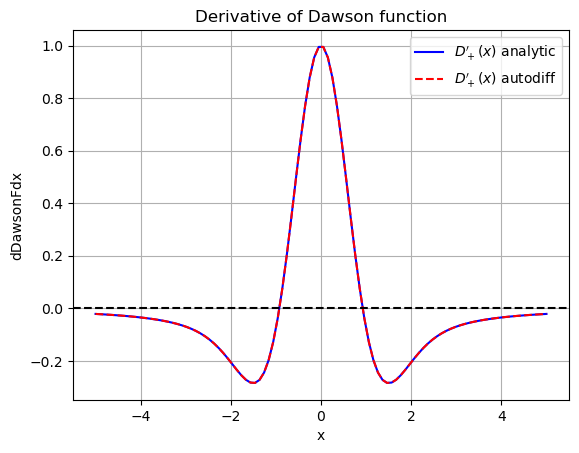Lecture Materials
Automatic differentiation#
Method#
Automatic differentiation (also known as algorithmic differentiation) is a powerful computational technique for calculating derivatives of functions that are specified as computer programs. Unlike numerical differentiation methods that use finite differences, automatic differentiation computes derivatives with machine precision, without truncation or round-off errors.
Automatic differentiation is based on the fundamental observation that every computer calculation, no matter how complex, ultimately executes a sequence of:
Elementary arithmetic operations (addition, subtraction, multiplication, division)
Elementary functions (exponential, logarithm, trigonometric functions, etc.)
For each of these basic operations, the derivatives are well-known and can be computed exactly. This allows us to compute the derivatives of any function specified as a computer program by applying the chain rule, by viewing any computer calculation as evaluating a composite function:
Computational Process#
Forward evaluation: The function is evaluated step by step, with intermediate values stored:
\[y = f(g(h(x))) = f(g(h(w_0))) = f(g(w_1)) = f(w_2) = w_3\]Derivative calculation: The derivative is computed by applying the chain rule:
\[\frac{\partial y}{\partial x} = \frac{\partial y}{\partial w_2} \frac{\partial w_2}{\partial w_1} \frac{\partial w_1}{\partial x} = \frac{\partial f(w_2)}{\partial w_2} \frac{\partial g(w_1)}{\partial w_1} \frac{\partial h(w_0)}{\partial x}\]

Automatic differentiation has several advantages over finite differences and other methods:
The resulting calculation is theoretically exact (up to machine precision)
It can be more efficient than symbolic differentiation for complex functions, usually requiring a constant factor more calculations compared to the function evaluation
It can be extended to compute higher-order derivatives and partial derivatives
The main drawback of automatic differentiation is that it requires additional overhead in modifying the code to compute the derivatives. Further, the method fails when the function is not differentiable or if the function is not smooth, for instance when the evaluation heavily relies on branching logic (if-statements, recall bisection or golden-section methods) or piecewise functions.
Forward mode#
There are two main modes of automatic differentiation: forward mode and reverse mode.
Forward mode is the most basic mode of automatic differentiation. It propagates derivatives forward through the computation. It is particularly efficient when we are interested in derivatives of many functions with respect to few variables.
Reverse mode#
Reverse mode builds the tree of operations and propagates derivatives backward through the computation. It is particularly efficient when we are interested in derivatives of few functions with respect to many variables, as is the case in training neural networks. Backpropagation is a special case of reverse mode automatic differentiation. Reverse mode usually requires more memory than forward mode.
Implementation#
Automatic differentiation can be implemented in several ways. The easiest way is to use a library that implements automatic differentiation. In Python, we can use
MyGrad: https://mygrad.readthedocs.io/en/latest/ which implement automatic differentiationautograd: HIPS/autogradPyTorch: https://pytorch.org/
In C++ we can use autodiff (autodiff/autodiff), which would require writing the code using C++ templates.
Preliminaries#
Here we will use
or
MyGrad: https://mygrad.readthedocs.io/en/latest/ which implement automatic differentiation
Install jax if you do not have it already: https://docs.jax.dev/en/latest/installation.html
pip install -U jax
Examples#
Consider a polynomial function
Its derivative is
def f(x):
return x**3 - 2*x**2 + x - 2
def df(x):
return 3 * x**2 - 4 * x + 1
# Print f(x) and f'(x) for x=0,1,2
# Output in column format
# Print header
print(f"{'x':>3s} {'f(x)':>10s} {'df/dx':>10s}")
x_values = np.arange(0, 3, 0.2)
for x in x_values:
print(f"{x:3.1f} {f(x):10.4f} {df(x):10.4f}")
x f(x) df/dx
0.0 -2.0000 1.0000
0.2 -1.8720 0.3200
0.4 -1.8560 -0.1200
0.6 -1.9040 -0.3200
0.8 -1.9680 -0.2800
1.0 -2.0000 0.0000
1.2 -1.9520 0.5200
1.4 -1.7760 1.2800
1.6 -1.4240 2.2800
1.8 -0.8480 3.5200
2.0 0.0000 5.0000
2.2 1.1680 6.7200
2.4 2.7040 8.6800
2.6 4.6560 10.8800
2.8 7.0720 13.3200
Now use automatic differentiation with jax in forward (jvp) and reverse (grad) modes
import jax.numpy as jnp
from jax import grad
from jax import jvp
# Autodiff derivative forward mode
def dfdx_auto_forward(func, x):
x_val = jnp.array(x)
dx = jnp.array(1.0)
y, dy = jvp(func, (x_val,), (dx,))
return dy
# Autodiff derivative reverse mode
def dfdx_auto_reverse(func, x):
return grad(func)(x)
print(f"{'x':>3s} {'f(x)':>10s} {'df/dx_analyt':>15s} {'df/dx_ad_forw':>15s} {'df/dx_ad_reve':>15s}")
x_values = np.arange(0, 3, 0.2)
for x in x_values:
print(f"{x:3.1f} {f(x):10.4f} {df(x):15.4f} {dfdx_auto_forward(f,x):15.4f} {dfdx_auto_reverse(f,x):15.4f}")
x f(x) df/dx_analyt df/dx_ad_forw df/dx_ad_reve
0.0 -2.0000 1.0000 1.0000 1.0000
0.2 -1.8720 0.3200 0.3200 0.3200
0.4 -1.8560 -0.1200 -0.1200 -0.1200
0.6 -1.9040 -0.3200 -0.3200 -0.3200
0.8 -1.9680 -0.2800 -0.2800 -0.2800
1.0 -2.0000 0.0000 0.0000 0.0000
1.2 -1.9520 0.5200 0.5200 0.5200
1.4 -1.7760 1.2800 1.2800 1.2800
1.6 -1.4240 2.2800 2.2800 2.2800
1.8 -0.8480 3.5200 3.5200 3.5200
2.0 0.0000 5.0000 5.0000 5.0000
2.2 1.1680 6.7200 6.7200 6.7200
2.4 2.7040 8.6800 8.6800 8.6800
2.6 4.6560 10.8800 10.8800 10.8800
2.8 7.0720 13.3200 13.3200 13.3200
One can see that automatic differentiation results reproduce the analytical derivative.
Mixing AD with other numerical methods#
Automatic differentiation can be combined with other numerical methods.
Consider the Dawson function:
Let us evaluate \(D_+(x)\) using 32-point Gaussian quadrature. The hidden cell below initializes the quadrature.
Show code cell content
from numpy import ones,copy,cos,tan,pi,linspace
# Generic integration using quadratures
def integrate_quadrature(
f, # Function to be integrated
quad # A pair of lists (x,w) where x are the integration nodes and w are the weights
):
ret = 0.
n = len(quad[0])
for k in range(n):
xk = quad[0][k]
wk = quad[1][k]
ret += wk * f(xk)
return ret
######################################################################
#
# Functions to calculate integration points and weights for Gaussian
# quadrature
#
# x,w = gaussxw(N) returns integration points x and integration
# weights w such that sum_i w[i]*f(x[i]) is the Nth-order
# Gaussian approximation to the integral int_{-1}^1 f(x) dx
# x,w = gaussxwab(N,a,b) returns integration points and weights
# mapped to the interval [a,b], so that sum_i w[i]*f(x[i])
# is the Nth-order Gaussian approximation to the integral
# int_a^b f(x) dx
#
# This code finds the zeros of the nth Legendre polynomial using
# Newton's method, starting from the approximation given in Abramowitz
# and Stegun 22.16.6. The Legendre polynomial itself is evaluated
# using the recurrence relation given in Abramowitz and Stegun
# 22.7.10. The function has been checked against other sources for
# values of N up to 1000. It is compatible with version 2 and version
# 3 of Python.
#
# Written by Mark Newman <mejn@umich.edu>, June 4, 2011
# You may use, share, or modify this file freely
#
######################################################################
from numpy import ones,copy,cos,tan,pi,linspace
def gaussxw(N):
# Initial approximation to roots of the Legendre polynomial
a = linspace(3,4*N-1,N)/(4*N+2)
x = cos(pi*a+1/(8*N*N*tan(a)))
# Find roots using Newton's method
epsilon = 1e-15
delta = 1.0
while delta>epsilon:
p0 = ones(N,float)
p1 = copy(x)
for k in range(1,N):
p0,p1 = p1,((2*k+1)*x*p1-k*p0)/(k+1)
dp = (N+1)*(p0-x*p1)/(1-x*x)
dx = p1/dp
x -= dx
delta = max(abs(dx))
# Calculate the weights
w = 2*(N+1)*(N+1)/(N*N*(1-x*x)*dp*dp)
return x,w
def gaussxw(N):
# Initial approximation to roots of the Legendre polynomial
a = linspace(3,4*N-1,N)/(4*N+2)
x = cos(pi*a+1/(8*N*N*tan(a)))
# Find roots using Newton's method
epsilon = 1e-15
delta = 1.0
while delta>epsilon:
p0 = ones(N,float)
p1 = copy(x)
for k in range(1,N):
p0,p1 = p1,((2*k+1)*x*p1-k*p0)/(k+1)
dp = (N+1)*(p0-x*p1)/(1-x*x)
dx = p1/dp
x -= dx
delta = max(abs(dx))
# Calculate the weights
w = 2*(N+1)*(N+1)/(N*N*(1-x*x)*dp*dp)
return x,w
gaussxw32 = gaussxw(32)
def gaussxwab32(a,b):
x,w = gaussxw32
return 0.5*(b-a)*x+0.5*(b+a),0.5*(b-a)*w
from jax.numpy import exp
def DawsonF(x):
def fint(t):
return exp(t**2)
x2 = x**2
gaussx, gaussw = gaussxwab32(0,x)
return exp(-x2) * integrate_quadrature(fint, (gaussx, gaussw))

The derivative of Dawson function can be computed explicitly by differentiating its defition: $\( D_{+}'(x) = 1 - 2x D_+(x). \)$
This expression can be used to verify the accuracy of automatic differentiation
from jax import jvp
# Analytic derivative
def dDawsonFdx(x):
return 1. - 2. * x * DawsonF(x)
# Forward mode AD
def dDawsonFdx_auto_forw(x):
return dfdx_auto_forward(DawsonF, x)
# Reverse mode AD
def dDawsonFdx_auto_reve(x):
return dfdx_auto_reverse(DawsonF, x)
# Compute and plot both derivatives from -5 to 5
x = np.linspace(-5, 5, 100)
df_vals = [dDawsonFdx(xi) for xi in x]
# Use forward mode
df_auto_vals = [dDawsonFdx_auto_forw(xi) for xi in x]
plt.plot(x, df_vals, label="${D_+'(x)}$ analytic", color="blue", linestyle="-")
plt.plot(x, df_auto_vals, label="${D_+'(x)}$ autodiff", color="red", linestyle="--")
plt.axhline(0, color="black", linestyle="--")
plt.title("Derivative of Dawson function")
plt.xlabel("x")
plt.ylabel("dDawsonFdx")
plt.legend()
plt.grid()
plt.show()

Timing the performance
%%time
# Timing the autodiff derivative forward mode
x = np.linspace(-5, 5, 100)
df_auto = [dDawsonFdx_auto_forw(xi) for xi in x]
print("Done")
Done
CPU times: user 2.58 s, sys: 8.15 ms, total: 2.59 s
Wall time: 2.21 s
%%time
# Timing the autodiff derivative reverse mode
x = np.linspace(-5, 5, 100)
df_auto = [dDawsonFdx_auto_reve(xi) for xi in x]
print("Done")
Done
CPU times: user 5.88 s, sys: 38.2 ms, total: 5.91 s
Wall time: 6 s
MyGrad#
Now let us try MyGrad from rsokl/MyGrad
import mygrad as mg
def f(x):
return x**3 - 2*x**2 + x - 1
def df(x):
return 3 * x**2 - 4 * x + 1
def dfdx_mygrad(func, x):
xx = mg.Tensor(x)
y = func(xx)
y.backward()
return xx.grad
print(f"{'x':>3s} {'f(x)':>10s} {'df/dx_analyt':>15s} {'df/dx_ad_mygrad':>15s}")
x_values = np.arange(0, 3, 0.2)
for x in x_values:
print(f"{x:3.1f} {f(x):10.4f} {df(x):15.4f} {dfdx_mygrad(f,x):15.4f}")
x f(x) df/dx_analyt df/dx_ad_mygrad
0.0 -1.0000 1.0000 1.0000
0.2 -0.8720 0.3200 0.3200
0.4 -0.8560 -0.1200 -0.1200
0.6 -0.9040 -0.3200 -0.3200
0.8 -0.9680 -0.2800 -0.2800
1.0 -1.0000 0.0000 0.0000
1.2 -0.9520 0.5200 0.5200
1.4 -0.7760 1.2800 1.2800
1.6 -0.4240 2.2800 2.2800
1.8 0.1520 3.5200 3.5200
2.0 1.0000 5.0000 5.0000
2.2 2.1680 6.7200 6.7200
2.4 3.7040 8.6800 8.6800
2.6 5.6560 10.8800 10.8800
2.8 8.0720 13.3200 13.3200
Dawson function#
from mygrad import exp
def DawsonF(x):
def fint(t):
return exp(t**2)
x2 = x**2
gaussx, gaussw = gaussxwab32(0,x)
return exp(-x2) * integrate_quadrature(fint, (gaussx, gaussw))
print(dfdx_mygrad(DawsonF, 1.0))
-0.07615901382553736
# Analytic derivative
def dDawsonFdx(x):
return 1. - 2. * x * DawsonF(x)
dDawsonFdx_mg_reve = lambda x: dfdx_mygrad(DawsonF, x)
# Plot both derivatives from -5 to 5
x = np.linspace(-5, 5, 100)
df_vals = [dDawsonFdx(xi) for xi in x]
df_auto_vals = [dDawsonFdx_mg_reve(xi) for xi in x]
plt.plot(x, df_vals, label="${D_+'(x)}$ analytic", color="blue", linestyle="-")
plt.plot(x, df_auto_vals, label="${D_+'(x)}$ autodiff", color="red", linestyle="--")
plt.axhline(0, color="black", linestyle="--")
plt.title("Derivative of Dawson function")
plt.xlabel("x")
plt.ylabel("dDawsonFdx")
plt.legend()
plt.grid()
plt.show()

%%time
# Timing the MyGrad autodiff derivative reverse mode
x = np.linspace(-5, 5, 100)
df_auto = [dfdx_mygrad(DawsonF,xi) for xi in x]
# df_auto = dfdx_mygrad(DawsonF,x)
print("Done")
Done
CPU times: user 791 ms, sys: 3.01 ms, total: 794 ms
Wall time: 373 ms

